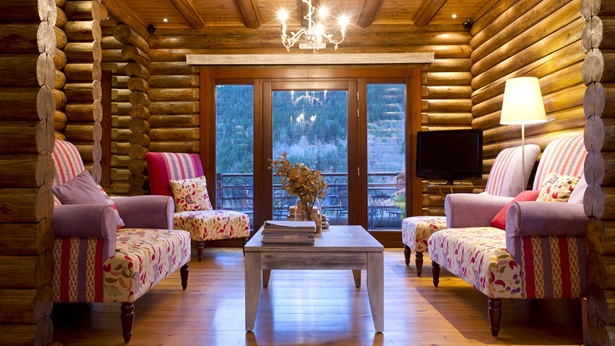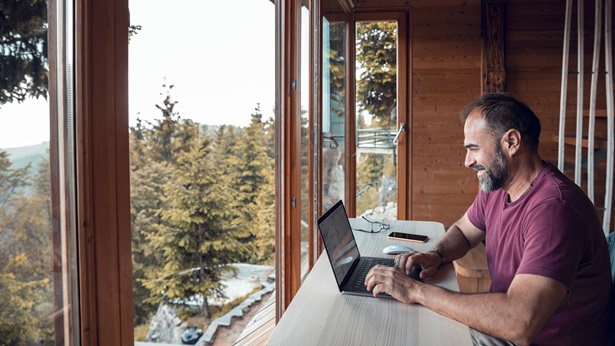Choosing Your Front Door
Which is Best for Your Log or Timber Home?
Although it may seem like an innocuous line item on your builder’s material specification checklist, the front door for your new log and timber home is a design opportunity that you don’t want to miss out on. Even though most of us now enter our homes through the garage, the front door is still an important architectural design statement, setting the tone for the rest of your home.
Your front door should also be able to endure rigorous wear and tear. It should be able to weather exposure to the elements and glide silently on its hinges while fitting snugly into its jamb to keep out cold, heat and moisture — as well as any unwelcome visitors.
Like every other material that goes into your home, it comes in a range of prices. Rest assured there are enough choices to satisfy any budget. But keep in mind that one may need to order a door six to eight weeks before you need to install it, according to the experts at the Log and Timber Homes Council, which has been providing crucial information to consumers since 1977.
Depending on the material you choose, the size of the door and the amount of decorative glass you want to include, a prehung exterior door system can cost anywhere from $1,000 to more than $20,000.
Why such a large investment for a simple way to get in and out of your house? Much of it has to do with the craftsmanship and technology that goes into today’s doors. But there are also cultural influences at work. Back in the day, the front door played a much more significant role in our society.
When the pace of life was measured in footsteps — or hoof beats if you were wealthy enough to ride — the main entrance was a status symbol in much the same way our automobiles are today.
Because it faced the street and the neighborhood at large, the front door was a symbol of your standing in the community and a formal stage for welcoming visitors. This is why in historical structures one discovers that even people of modest means would invest a great deal in an elegant front door.
How can you capture some of that old world charm for your new log and timber home? To choose the right door you will have to weigh a host of factors beyond mere price, including the aesthetic merits of the various materials, maintenance requirements, energy efficiency, strength and security, as well as your home’s solar orientation and local climate.
If you’re planning the construction of your new log and timber home, you’ll need to educate yourself on the materials that go into today’s exterior doors to make an informed choice. The most popular materials for exterior doors today are metal, fiberglass, wood and wood composite. Each has its own advantages and disadvantages. While we have indicated an average range of cost for each material in a six-panel door in a standard size (usually 6 feet, 8 inches high and either 2 feet, 8 inches or 3 feet wide), keep in mind that the cost of any particular door will depend on a host of other factors. This can include the time of year you order the door, region you’re building, door size, raised or flat panels, type of finish, fire rating, whether it will include decorative glass in the door and whether you'll need an entire entry system, including side lights and a transom.
Metal
Thanks to their durability and price point (less than a third of custom wood doors), metal doors are among the most popular exterior doors installed in new construction. Just because they are metal doesn’t mean they have to be ugly. Some manufacturers duplicate the appearance of wood grain with texture lines stamped into the metal.
Because these steel doors are often filled with insulating foam or a wood-and-foam core, they offer greater insulating properties or R-value than wood doors. Inherently strong, steel doors are often the solution when fire protection or security is an issue. Building codes often require a fire-rated door between the home and the attached garage, which explains the popularity of this material.
Steel can come in different gauges or thickness to provide different levels of security. Steel doors can be rated for keeping smoke and fire at bay, from 20 to 90 minutes, with the price of the door rising proportionately to its fire rating. Is there a downside to these doors beyond tactile feel? They can be scratched and dented on moving day.
Pros: Strong, energy efficient, impervious to climatic changes and inexpensive, these metal doors have the added benefit of coming from the factory primed for painting, making installation a snap. They can offer unsurpassed security for keeping out unwelcome visitors, depending on the gauge of metal.
Cons: Cold to the touch, metal doors can be scratched and dented by the daily wear and tear of life, such as rambunctious kids and dogs anxious to go for a walk. Rust never sleeps, so these scratches and dents can turn into real problems over time, especially in humid climates. Plus, do you really need doors this secure when windows are so easy to break?
Cost: As little as $139 for a simple prehung six-panel door without hardware or locksets from a big box hardware stores. These can run $500 to more than a $2,500 installed, depending on configuration and design. Decorative glass and brass hardware will cost more.
Fiberglass
Exterior doors made of fiberglass have the look and warmth of wood, yet have the many of the durable qualities of steel. Fiberglass won’t dent or rust like steel will and it won’t crack, split, splinter or warp like wood. They also resist swelling and shrinking like wood doors do, when subjected to moisture and temperature changes.
Fiberglass doors offer the same energy efficiency as steel doors, because many incorporate solid polyurethane foam cores that give greater insulating value than wood. They also have wood grain texture molded into the face of the door so they give the appearance of a real wood door when painted or stained. These doors are often the first choice for extreme climates.
Fiberglass doors are impervious to salt, for example, so they are often employed in homes near the beach. In years past, some fiberglass doors were distinctly light in weight. That light weight put off home owners interested in the feel of a heavy front door. This is not the case today, with fiberglass doors weighing nearly as much as wood doors.
Prices of fiberglass doors fall somewhere between steel and wood.
Pros: These doors can dish out energy efficiency while taking all kinds of wear and tear from use and the environment. They accept stains much like wood doors do and with their lifelike wood grain texture, they go well with log and timber frame homes.
Cons: Some homeowners simply do not want anything unnatural in their log and timber home. For these people, fiberglass will always be an imitation and therefore not as good as wood. Plus, these doors do need to be stained and sealed on all six sides after installation and over time to maintain the surface, just like wood.
Cost: Fiberglass exterior doors start at around $1,300. This can climb to more than $4,000 when you add in hardware or sidelights.
Wood
The natural beauty of wood doors is often the first choice among log and timber frame home buyers who want to preserve the integrity and aesthetic feel of their new home. The substantial weight of a wooden door adds a sense of security and sturdiness when you shut your door. However, to maintain their natural, warm appearance, they will need to be stained or painted on a regular basis. If your front door is south facing without the protection of a porch, this maintenance will be needed every year or every other year.
These types of doors are usually made using frame and panel construction from kiln dried wood to counteract the effects of climatic or seasonal changes. The wood itself can be any hardwood species — maple, mahogany, oak, alder. And just as with the logs in your new home, these doors may warp or twist, especially when not sealed properly against temperature changes and moisture. Wood doors have lower R-values than other types of doors. However, it is an excellent insulator against temperature changes.
Pros: A custom handcrafted door sends an inviting message of home and hearth to visitors and is completely within character for a log and timber home. It will serve as both an architectural focal point and a conversation piece for years to come. They accept stains to match your log walls and can seal your home tightly from the effects of Mother Nature.
Cons: If not constructed correctly with kiln-dried wood and protected from the elements with routine maintenance, these doors will give you problems. The result will be drafts and poor energy performance.
Cost: Solid wood doors constructed from kiln dried, furniture grade wood start at about $2,020 for maple, ash, red oak or eastern white pine, according to Vintage Doors. Spanish cedar is is a little more ($2,295), as is African mahogany or white oak at $2,470.
Wood Composite
Wood-composite or molded skin doors look very much like natural wood, but they provide better insulation because of their foam cores. The doors share the same internal construction as the steel or fiberglass, but they are covered with hardboard skins molded in the shape of traditional stile-and-rail doors.
Manufacturers such as Masonite, Jeld-Wen, Weyerhaesuser and Caradco process wood scraps, sawdust and other wood detritus into a soft, fuzzy mass of wood fibers that is mixed with binders and loosely arranged on conveyor belts. These conveyor belts then feed these long sheets of what resembles damp oatmeal into enormous stamping presses that heat and compress the material into molded door skins. These skins are stamped with a wide variety of designs that include smooth or wood-grained surfaces, arched or straight rails, and different panel configurations.
Pros: It’s the look and feel of wood with none of the upkeep associated with handcrafted wood doors. Plus, you have better thermal performance than regular wood and they are unaffected by the elements and are far more stable than wood, which can shrink or expand due to humidity. The skins resist abuse fairly well, too, having a density similar to hardwoods like maple or alder.
Cons: If these doors are scarred by a clumsy mover or scratched repeatedly by an anxious pet, it can be difficult to repair. Once the skin is broken, it can be difficult to mask the damage completely.
Cost: About $2,000 for prehung six-panel door with locksets and hardware. Decorative glass and sidelights cost more.



